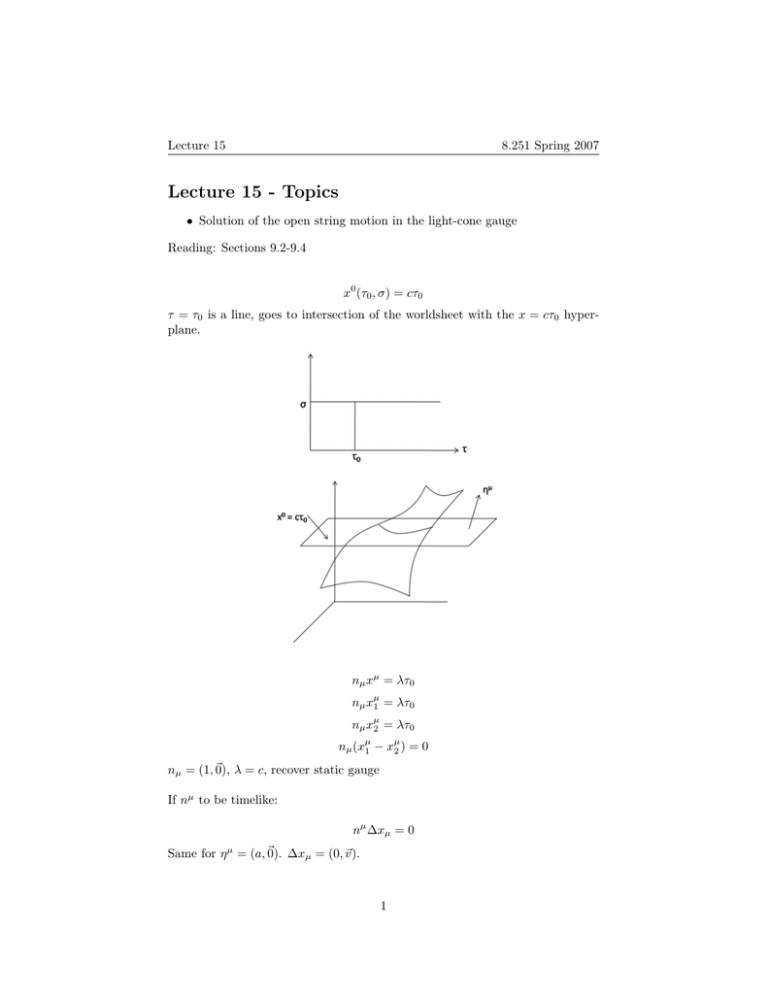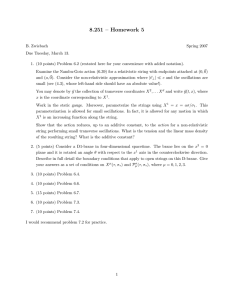Lecture 15 - Topics
advertisement

Lecture 15 8.251 Spring 2007 Lecture 15 - Topics • Solution of the open string motion in the light-cone gauge Reading: Sections 9.2-9.4 x0 (τ0 , σ) = cτ0 τ = τ0 is a line, goes to intersection of the worldsheet with the x = cτ0 hyper­ plane. nµ xµ = λτ0 nµ xµ1 = λτ0 nµ xµ2 = λτ0 nµ (xµ1 − xµ2 ) = 0 nµ = (1, �0), λ = c, recover static gauge If nµ to be timelike: nµ Δxµ = 0 Same for η µ = (a, �0). Δxµ = (0, �v ). 1 Lecture 15 8.251 Spring 2007 Set λ usefully (aim at τ, σ dimensionless) �(n · p)τ n · x(τ, σ) = λ ���� const Pµ = σ1 � P τ µ dσ 0 dP µ = −P σµ dτ d dτ (n σ Ask for n · P = 0 at endpoints so that �σ1 0 · p) = 0. Reminder of Units: J: Angular momentum of rotating string [α� ] = 1 [E ]2 since J h̄ J = α� E 2 h̄ is dimensionless. Let’s use natural units (as opposed to Planck units), set c = 1, h̄ = 1. Thus: L =1 T M L2 = 1 ⇒ M L = 1 Thus everything can be written in terms of units of length (sometimes people use mass instead) 1 1 2 So in natural units, [α� ] = [E] 2 = M 2 = L . So string length ls = units (to get actual numbers, must replace the c’s and h̄’s) √ ls = h̄c α� In natural units: T0 1 = πα� c 2 To remember: √ ls = α� T0 1 = πα� c 2 � ] = L2 ⇒ λ � ∝ α� . Back to I. L = [�] L1 ⇒ [λ As it turns out, n · x = 2α� (n · p)τ (the 2 will be convenient) 2 √ α� in natural Lecture 15 8.251 Spring 2007 σ parameterization Static gauge: Pτo = = T0 (x� )2 ẋo √ c . . . T0 (∂�x/∂σ)2 � 2 /c2 c ds/dσ 1 − v⊥ � ∂�x ∂σ Pτ0 = �2 � = ds dσ �2 T0 ds/dσ � 2 /c2 c 1 − v⊥ 1. Try to make n · P τ constant along the parameterized string. 2. Get a range σ ∈ [0, π] �τ µ (τ, σ). If change parameter, how does it Imagine had some parameter σ �,P transform? Claim transformation law: dσ � �τ µ P (τ, σ �) dσ Makes sense that P τ µ dσ is reparam. invar. P τ µ (τ, σ) = Multiply by n: dσ � � σ n · P(τ, �) dσ Can set to be A is constant with respect to σ, might be a function of τ � σ1 n · P τ (τ, σ) = σ1 A(τ ) n · P τ (τ, σ) = 0 Also � = n · P (momentum). So, A(τ ) = n · p/σ. A not τ dependent! n · P τ (τ, σ) = n · p σ1 n · P τ (τ, σ) = n·p π σ ∈ [0, π] Recall eq. of motion of string: 3 Lecture 15 8.251 Spring 2007 ∂P σµ ∂P σµ + =0 ∂τ ∂σ Dot with nµ ∂ ∂ (n · P τ ) + (n · P σ ) = 0 ∂τ ∂σ ∂ (n · P σ ) = 0 ∂σ We had n · P σ = 0 at string boundaries (σ = 0, σ = σ1 = π) and since σ ∂ σ ∂σ (n · P ) = 0, n · P = 0 ∀σ and ∀ times. Closed Strings n · x = 2α� (n · p)τ For closed strings, more convenient to remove 2: n · x = α� (n · p)τ n · P τ (τ, σ) = n·P σ = 0??? Do have ∂ σ ∂σ (n·P ) n·p 2π = 0, but don’t have endpoints having n·P σ = 0. Open strings give rise to E&M. Closed strings give rise to gravity (harder! more subtle). For a closed string, know how to put σ param. on strings at different times, but we don’t know how to correlate these “σ ticks”. No special points on closed string like endpoints on open string. Compute: n · Pσ = 1 (ẋ · x� ) − ẋ2 ∂σ (n� · x) √ 2πα� ... n · x ∝ τ , so ∂σ (n · x) = 0, so to get n · P σ = 0, make ẋ · x� = 0. So in spacetime sense want ẋ⊥x� . x� : tangent to string ẋ: line of constant σ If given space vector x� and ∃ timelike vector, then ∃ unique vector orthogonal to x� prop to ẋ. So we lock the params. on the string, but still remains the ambiguity of translation of string (where do we set σ = 0 No one knows.) 4 Lecture 15 8.251 Spring 2007 Summary 1. n · x = βα� (n · p)τ where β = 2 if open string, or 1 if closed string. 2. n · Pτ = npβ 2π 3. σ ∈ [0, 2π ] β 4. n · P σ = 0 everywhere ⇒ ẋ · x� = 0 Pµτ = 1 x�2 ẋµ √ � 2πα −ẋ2 x�2 Dot by n n · Pτ = 1 x�2 (n · p)β √ βα� (n · p) = 2 �2 2πα −ẋ x 2π 1= x�2 −ẋ2 x�2 (x�2 )2 = −(ẋ2 )(x�2 ), (x� )2 �= 0 x�2 = ẋ2 ẋ2 + x�2 = 0 Using (4), get: (ẋ ± x� )2 = 0 In static gauge, got: � � ∂�x 1 ∂�x ± =1 ∂σ c ∂t Pτµ = 1 ∂xµ 2πα� ∂τ 5 Lecture 15 8.251 Spring 2007 P σµ = − 1 ∂xµ 2πα� ∂σ Eq. of Motion: ẍµ − xµ�� = 0 Wave equation for everyone! 6






